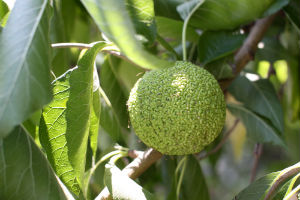The Health Benefits of the Osage Tree |  |
| The Health Benefits of the Osage Tree Posted: 10 Aug 2014 08:00 AM PDT  Highly revered in Native American cultures, the Osage tree is has been looked to for centuries for its multiple health and agricultural benefits. The bark, fruits, and leaves all contain a certain level of phytonutrients and chemicals, compounds that are attributed to the tree's proposed health benefits. Its volatile oils make it a strong, natural insecticide, and many of its compounds have also been shown to protect the body against bacteria, fungus, and other dangerous microbes. While little scientific investigation has been performed on the Osage tree, the available literature does give insight into the tree’s power to assist human health.
Health Benefits of Osage TreeThe benefits of Osage tree, or Maclura pomifera, are numerous, ranging from immune system support to cardiovascular protection. Despite the researched benefits of the leaves, bark, and fruit, very few research has delved into its full range of health advantages. Here are just a few of the studied benefits: Bacterial and Fungal ProtectionSome research shows that the Osage tree contains potent compounds responsible for fighting various types of fungus and bacteria. Research is ongoing to determine how these compounds can be applied to human health. [1] The main chemical compound that exhibits fungal- and bacterial-fighting abilities is 2,3,4,5-tetrahydroxystilbene and is found primarily in the wood. [2] Cardiovascular SupportHeart disease is the number one killer among men and women alike, and researchers are scrambling to find solutions to this deadly issue. Flavonoids found in the Osage tree — osajin and pomiferin — have been shown to reduce myocardial dysfunction in animal models. It is believed that the benefit lies in the antioxidants’ power to suppress oxidative stress, directly correlating to improved cardiovascular function. [3] Antioxidant PowerMany chronic degenerative diseases are amplified by oxidative stress, a type of metabolic disorder that is often induced by diet and environmental toxins. Dietary antioxidants have shown a great deal of promise for decreasing oxidative stress in the body and supporting overall health. The Osage tree contains high levels of isoflavones, a type of antioxidant that may be comparable in function to that of vitamin C and E. [4] Immune System SupportThe immune system is the most important factor for supporting our health, providing a barrier against infectious and viral bacteria. It also plays a role in cancer expression and suppression. The immune system can become compromised through stress, an improper diet, and lack of exercise. Research shows that pomiferin, the natural compound antioxidant in the Osage tree, significantly inhibits cancer cell viability by possibly improving the functioning of the immune system. More research is needed to determine the conclusive relationship between cancer and the Osage tree. [5] InsecticideUnlike other trees, the Osage tree is typically free from pests, an allusion to its possible natural insecticide activity. Concentrated compounds extracted from the fruit of the Osage tree may repel insects; however, very little research has been conducted to be conclusive on this benefit. [6] One Final ThoughtThe Osage tree shows much promise in the field of natural health, and it’s only through an increased public interest and more research that we will start seeing further applications. Whether it’s fighting off harmful pathogens or keeping the immune system in check, this natural health-supportive tree may see an array of benefits reported in future scientific journals. If thinking about supplementing with any aspect of the tree, be sure to speak with your doctor. Have you ever heard of the Osage tree? What are your thoughts on its benefits? Please let us know in the comments! -Dr. Edward F. Group III, DC, ND, DACBN, DCBCN, DABFM References:
The post The Health Benefits of the Osage Tree appeared first on Natural Health & Organic Living Blog. |
| You are subscribed to email updates from Natural Health & Organic Living Blog To stop receiving these emails, you may unsubscribe now. | Email delivery powered by Google |
| Google Inc., 20 West Kinzie, Chicago IL USA 60610 | |
No comments:
Post a Comment